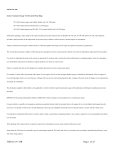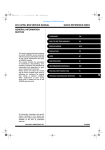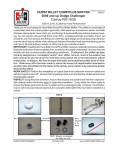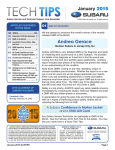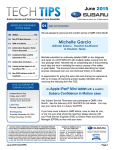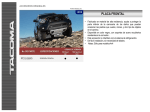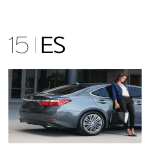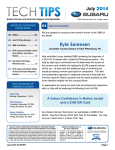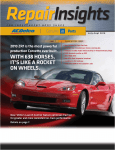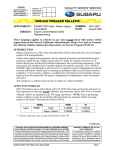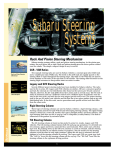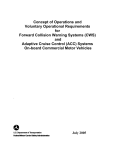Download April 2013
Transcript
April 2013 HELPING TO ACHIEVE THE PREMIUM SERVICE EXPERIENCE ARTICLES CONTAINED IN THIS ISSUE CODEARTICLE....................... PAGE (00) STIS Release Highlights from 03/01/2013 to 03/31/2013... 13 (01)Information You Should Always Have Ready When Calling the Techline........... 1 (01) QMR of the Month Winner .. 10 (02)Understanding the Relationships Between the Crank and Camshaft Position Sensors ......................... 4 (02)2013MY Legacy / Outback, Specification Change to Engine Under Cover ........... 8 (06)Proper Reporting of EyeSightRelated Issues ................. 8 (06)Precautions & Diagnostic Tips for EyeSight-Equipped Vehicles ......................... 9 (07)“Memory Height” Learning Procedure........................ 2 (07)Erratic Digital Fuel Gauge Operation, 2012MY and Later Impreza, BRZ and 2014MY Forester......................... 7 (07)Immobilizer / Key Registration Information..................... 1 (07)2014 Forester – Information Display Selection Knob (or the Right Side or “Other” Trip Knob)....................... 11 (11) WQD-40, A Reminder........ 10 01 Subaru Service and Technical Support Line Newsletter INFORMATION YOU SHOULD ALWAYS HAVE READY WHEN CALLING THE TECHLINE When calling the Subaru Techline or speaking with your DPSM or FSE, as a best practice, you should always have the following information available. This should be something that you do whenever you troubleshoot a DTC, whether you’re calling for assistance or not. Having this information available will help with your diagnosis. • Always Save the FFD before clearing any DTCs •A lways save the Getting of Vehicle Information screen so it is clear what CID the car has •A lways try to capture a data stream (SSMIII File) every time you are attempting to duplicate a condition. This is especially important when diagnosing an intermittent drivability, starting, or idle condition •W hile collecting this information should be considered a best practice all the time, it has considerable value now during the 2014 Forester launch as this information is frequently requested by the quality monitoring team. See the March 2013 Tech Tips for more details on this new model launch activity 07 IMMOBILIZER / KEY REGISTRATION INFORMATION The Techline has received inquiries about receiving a “SDI Not Connected” message while registering keys. It seems this occurs occasionally when using the SSMIII and the SDI box together for the key registration process. If the “SDI Not Connected” message appears on your SDI screen, disconnect the SSMIII, put the SDI box in standalone mode then resume the registration procedure. Instructions for operating the SDI in stand-alone mode start on pg. 266 of the user manual accessible by clicking on Help in the upper left of the SSMIII Main Menu screen. CAUTION: VEHICLE SERVICING PERFORMED BY UNTRAINED PERSONS COULD RESULT IN SERIOUS INJURY TO THOSE PERSONS OR TO OTHERS. SUBARU OF AMERICA, INC. IS “ISO 14001 COMPLIANT” The Subaru TechTIPS newsletter is intended for use by professional technicians ONLY. Articles are written to inform those technicians of conditions that may occur in some vehicles, or to provide information that could assist in the proper servicing of the vehicle. Properly trained technicians have the equipment, tools, safety instructions, and know-how to do the job correctly and safely. If a condition is described, DO NOT assume that your vehicle has or will have that condition. Impreza, Legacy, Justy, Loyale, Outback, Forester, Subaru SVX, WRX, WRX STI, L.L. Bean, Baja, Tribeca, BRZ, XV Crosstrek and “Quality Driven” are Registered Trademarks. The international standard for excellence in Environmental Management Systems. Please recycle or dispose of automotive products in a manner that is friendly to our environment and in accordance with all local, state and federal laws and regulations. April 2013 TechTIPS Page 1 07 “MEMORY HEIGHT” LEARNING PROCEDURE NOTE: The ignition should be off and the Power Rear Gate (PRG) should be closed when starting this procedure. 1. Push the “Memory Height SW” on the instrument panel in so that it is at its lowest position. (ON) Memory Height Switch Location Memory Height Switch Highest Setting (OFF) Memory Height Switch Lowest Setting (ON) Warning: Keep away from the closing area of the power rear gate (PRG). The outer edge of the rear gate (PRG) beyond the touch sensor cannot detect solid objects and will not trigger a safety maneuver until the amperage of the rear gate (PRG) exceeds pre-established specifications. Continued... April 2013 TechTIPS Page 2 07 “MEMORY HEIGHT” LEARNING PROCEDURE Gate Opener Switch 2.Set the PRG to manual mode by pushing the “Opener SW” on the gate for more than 0.8 seconds. NOTE: Immediately open the PRG so that the auto close function does not engage. 3.Open the gate manually, until the position of your preference is reached and then push and hold the “Gate Inner SW” for more than 3 seconds. A beep notifies you that a memorized position has been set. 4. Push down the gate manually towards a position before the complete close point and then wait until the gate closes completely through the auto closing function. 5. The “Memory Height SW” on the instrument panel must be kept in the on position (lowest position) for the PRG to open only to the memorized position. 6.The Full open position of the PRG can be obtained by pushing the “Memory Height SW” on the instrument panel to its highest (OFF) position and then pressing any of the opener switches. 7.Manual mode can be activated by pushing the Opener SW on the gate for more than 0.8 seconds if the “Memory Height SW” is at its lowest setting (ON). 8.The memorized position is not erased if the PRG control unit power is removed. The memory once set cannot be erased, only overwritten. CAUTION: DO NOT move the PRG manually if the PRG is opened to a memorized position. Damage to the half stop pin or solenoid will occur. April 2013 TechTIPS Page 3 02 UNDERSTANDING THE RELATIONSHIPS BETWEEN THE CRANK AND CAMSHAFT POSITION SENSORS When setting up your oscilloscope to check Camshaft Position Sensor data, also select the Crankshaft Position Sensor data to help your understanding. It is important to arrange your selections in the order shown in the following screen shot examples. The Crank sensor data will make it easier to establish the firing order and identify cam sensor waveform inconsistencies. Example 1 on the next page is a perfectly normal pattern for all 3 sensors. Let’s look at some specifics of the data which will help you determine a “good” pattern versus a “bad” one. Looking at the crank signal on page 4, you will see the difference between what we will call “1s” (a single spike) and “2s” (a double spike). This helps establish the engine’s firing order and what the corresponding cam sensor data should look like. The ECM looks for the “Edges” of the cam position sensor voltage drops to be within specified time “Window” parameters. The chart below Example 1 on the next page will help bring this all together. (Range was set to 250 msec / div. so the crank signal would be easier to understand here.) 2 1 2 Time “Window” 1 “Edges” (drops) “EXAMPLE 1” Continued... April 2013 TechTIPS Page 4 15 UNDERSTANDING THE RELATIONSHIPS BETWEEN THE CRANK AND CAMSHAFT POSITION SENSORS Engine Firing Order #1 #3 #2 #4 Crank Signal (“1” or “2”?) “1” “2” “1” “2” Is Cam Signal Edge Within Window RH? Yes No Yes Yes Is Cam Signal Edge Within Window LH? Yes Yes No Yes NOTE: A LH cam position sensor signal does not always indicate a corresponding #2 or #4 cylinder firing. (The same applies to the RH side.) Using the chart above and comparing it to Example 1, it can be determined the first cylinder shown in the screen shot is #3 because the crank signal is a “2” and there is an edge signal within the window on the LH but not the RH cam sensor. Next cylinder in the firing order would be #2 as the crank position signal is a “1” and there is an edge signal in the window for the RH but not for the LH, and so on…. Example 2 below shows a “Bad” pattern for the RH cam sensor. Marks #1 and #2 show what appears to be #4 cylinder firing but, the next cylinder to fire according to the screen shot is #2 followed by #4 then #1. The pattern for the RH sensor never shows the proper sequence to fire #3 cylinder. In this case, recheck the data again after installing a .2mm shim under the RH cam sensor. Proper Firing Order is: #3 #2 #4 #1 #3 #2 Firing Order shown in screen shot: #4 #2 #4 #1 #4 #2 Erratic Cam Sensor Signals “EXAMPLE 2” Continued... April 2013 TechTIPS Page 5 01 UNDERSTANDING THE RELATIONSHIPS BETWEEN THE CRANK AND CAMSHAFT POSITION SENSORS Example 3 shows what appears to be an erratic signal from the RH cam sensor but, you can see all the cam sensor data signal edges (drops) follow the chart and firing order as they are supposed to. Other signal edges (rises or drops) outside the “window” or a longer time line as shown here prior to the #4 signal edges seen on the RH cam sensor pattern are examples of signals which will be “ignored” by the ECM and are not a cause for concern. #4 #1 #3 Normal Cam Sensor Signals #2 #4 Rise outside of “Window” “EXAMPLE 3” This information should help you gain a better understanding of how to interpret camshaft position sensor data along with how it relates to the crankshaft position sensor output and the engine’s firing order. April 2013 TechTIPS Page 6 07 ERRATIC DIGITAL FUEL GAUGE OPERATION, 2012MY AND LATER IMPREZA, BRZ AND 2014MY FORESTER The Techline has been receiving inquiries about erratic digital fuel gauge operation on the models shown above after refueling. Examples of customer concerns include: the fuel gauge doesn’t react after filling the tank, low fuel indicator remains on after fueling, or the gauge only reads ¾ full after filling. The information below provides some insight to how the fuel gauge operates, refueling suggestions and some answers you can use when customers have related questions at the Service counter. Fuel Gauge Inaccuracy After A Partial Fill It is recommended that the ignition be turned completely “OFF” when adding fuel to the tank. Inaccurate fuel level indication on the gauge can occur if the ignition is left in the “ON” position while adding fuel in small quantities. Background of Mechanism The fuel gauge logic incorporates a shunt to prevent gauge fluctuation while driving on curvy roads, which causes the fuel to slosh in the tank and effectively change the level at the sending units while driving in this manner. If a small amount of fuel, approximately 4.25 US gallons (16 liters) or less is added to the tank while the ignition is in the “ON” position, the logic sees fuel slosh, rather than the actual increase in fuel level. Note that the fuel level will most likely not self correct over time or with multiple key cycles. In some cases, adding less than 2 gallons of fuel, even with the ignition in the “OFF” position, may result in no level increase on the gauge. An example of this may be a customer who adds only $5 in fuel and then notes no change in the gauge reading. This is not an indication of any mechanical failure! How To Restore Correct Fuel Level indication If this occurs, adding more fuel, more than 2 gallons, with ignition in the “OFF” position, will in most cases correct the condition. In some rare cases, it may be necessary to disconnect the battery negative cable for more than 10 seconds. The real “KEY” is to turn the “IGNITION OFF” anytime you are fueling the vehicle (following the caution placards found on nearly every gas pump). April 2013 TechTIPS Page 7 02 2013MY LEGACY / OUTBACK, SPECIFICATION CHANGE TO ENGINE UNDER COVER The front engine under cover currently used on 2013MY Legacy models will be phased out during the end of April. The replacement will be the same part currently in use on 2013MY Outback models. In the future, if you see an “Outback” under guard on a Legacy, it is normal and should not be replaced. S6410AJ00B after 4/13 production 06 S6410AJ01B (current) PROPER REPORTING OF EYESIGHT-RELATED ISSUES When a customer reports a concern with the operation of their EyeSight system, it is VERY important to take the time necessary and obtaining as much detailed information as possible prior to starting any diagnosis and / or repairs. To help make the procedure easier and minimize chances of missing any important information, there are 2 forms available on Subarunet we would like to remind you of: the Basic Diagnostic Procedure form and the Check List for Interview form. Both of these forms can be accessed by clicking on Subarunet > Service > Forms. Just click on the links shown in the righthand column of the forms page to download. Print and fill out both forms as completely as possible. When calling the Techline, be prepared to submit via fax or e-mail your completed forms so they can be attached to your case for future reference. In addition, both of these forms are available in the beginning of the EyeSight Diagnostics section of the applicable Service Manual. For additional information or instruction, you may want to attend the recently updated 501 Brake Systems and 602 Advanced Electrical classes. Both of these instructor-led modules now include information relating to operation and diagnosis of the EyeSight system. If you have already attended these classes or Module 923 for EyeSight and Keyless Access & Entry, don’t forget your TRB and / or the related TRB information available on STIS. April 2013 TechTIPS Page 8 06 PRECAUTIONS & DIAGNOSTIC TIPS FOR EYESIGHT-EQUIPPED VEHICLES With the all-new 2014 Forester being added to the list of Subaru models equipped with the EyeSight system, we felt it important to remind you of some precautions and provide some diagnostic tips to use when working with these vehicles. It would also be a good idea to pass the precautions along to your Sales staff and your customers to reinforce the information already available in the Owner’s Manual. To avoid unexpected activation of EyeSight’s Pre-Collision Braking System it must be turned OFF in the following situations: • When the vehicle is being towed or loaded onto a transporter • When testing the vehicle on a chassis dynamometer • When the vehicle is on a lift with the engine running and the wheels turning freely These situations are directed more toward customers: • • • • When passing under low-hanging banners or thick vegetation that may contact the vehicle When passing through automatic gates (e.g. parking garages or toll gates) When following the vehicle in front closely (e.g. bumper-to-bumper traffic conditions) When driving on hilly terrain where the grade of the road changes rapidly IMPORTANT: Remind your customers to turn EyeSight “OFF” when going through an automatic car wash to eliminate any chance of it activating unexpectedly. If the system is left “on” with the engine running, EyeSight may interpret the rotating brushes as an obstacle and activate the PreCollision Braking feature of the system. In addition, below are some reminders and quick diagnostic tips: • When replacing the windshield glass, use only a Genuine Subaru replacement glass which has the secure field of vision for the EyeSight® system and specific controlled light transmission rate • Be sure the rear view mirror is horizontal and not interfering with the stereo camera’s field of view. • Complete the EyeSight Checklist Interview form on Subarunet>Service>Forms>EyeSight Forms • Check for any stored DTCs • Check for any stored Cancel Codes • Read Camera Temporary Stop Counts • See the Technician Reference Booklet for Module 923 on STIS starting on pg. 70 for more helpful diagnostic tips April 2013 TechTIPS Page 9 01 QMR OF THE MONTH WINNER We are pleased to announce this month’s winner of the recently released QMR of the Month. Keith Mack from Flatirons Subaru in Boulder, CO Keith submitted a very detailed QMR on his diagnosis and repair of an extended engine cranking concern that resulted in enhancements to the existing Service Bulletin. In appreciation for going the extra mile and sharing his experience with us in hopes of improving product quality, Keith will be receiving the following from his FSE: A Subaru Confidence In Motion Jacket & A $100 Gift Card Congratulations Keith! Any Subaru Service Technician can participate in QMR of the Month. See the February 2013 Tech Tips for full details. You may see your name here in a future Tech Tips. 11 WQD-40, A REMINDER When searching for the appropriate reprogramming file for a vehicle that has an open WQD-40 campaign, be sure to carefully review Page 4 of the Campaign Bulletin. This page includes a chart of the special WQD-40 campaign-only CIDs which must be used when searching FlashWrite to locate the campaign-only reprogramming file. These files must only be installed on vehicles with a confirmed open WQD-40 campaign after the catalyst has been replaced. They must never be installed on vehicles which are outside of the campaign or prior to the required catalyst replacement. April 2013 TechTIPS Page 10 07 2014 FORESTER – INFORMATION DISPLAY SELECTION KNOB (OR THE RIGHT SIDE OR “OTHER” TRIP KNOB) Our Customer Dealer Services (CDS) center has received calls with customers’ questioning the function of the Information Display Selection Knob or what some people may refer to as the “Right Side” or “Other Trip Knob” as it sits directly opposite of the trip knob used to check and reset the trip odometer and turn the Instrument Gauge Needle Sweep Function on or off (needle sweep occurs at Key On). The information display selection knob is located on the right hand side of the instrument cluster. It is used on 2014 Forester 2.5i Standard models to control the display functions of the information display located in the upper center stack of the vehicle’s dashboard. This is a black and white display used to display the driving range on remaining fuel, average fuel consumption, current fuel consumption, journey time, and average vehicle speed as the information selection knob is cycled. It should not be confused with the color Multi Function Display which is found on 2.5i Premium, 2.5i Limited, 2.5i Touring, 2.5XT Premium and 2.5XT Touring models. On these models, the Driver’s information display selection knob is still present on the instrument cluster; however it has no interaction with the color multi-function display. On these models, the only function this knob has is when in Key OFF or ACC positions, it allows the driver to cycle through the trip odometer and needle sweep settings. In the Key ON or RUN positions, this knob has no functionality. The color multi-function display is controlled strictly by using the control switch on the steering wheel. Information display (if equipped) 1) Outside temperature indicator 2) Driving information display 3)Clock Driving information display 1) Information display selection knob Continued... April 2013 TechTIPS Page 11 07 2014 FORESTER – INFORMATION DISPLAY SELECTION KNOB OR THE RIGHT SIDE OR OTHER TRIP KNOB (CONTINUED) Control switch 1) Up (select) 2) Set (enter) 3) Down (select) Multi function display April 2013 TechTIPS Page 12 00 2013 Calendar of Subaru Holidays STIS RELEASE HIGHLIGHTS FROM 03/01/2013 TO 03/31/2013 MSA5M1412A; Owner Manual, 2014 BRZ, Forester, Impreza and XV Crosstrek Navigation System Owner’s Manual H451SAJ300; Accessory Installation Guide, 2013 Outback Fog Light Kit 18-167-13; Service Manual Correction, Service Manual Corrections (2007 - 2013MY Legacy & Outback) G4400BE; Service Manual, 2013 BRZ Service Manual v3 H451SAJ300; Accessory Installation Guide, 2013 Outback Fog Light Kit G8190BE; Service Manual, 2014 Forester Service Manual v1 17-17-13; Technical Service Bulletin, Event Data Recorder (EDR) Function of Airbag Module Memorial Day Monday, May 27, 2013 Independence Day Thursday, July 4, 2013 Labor Day Monday, September 3, 2013 Thanksgiving Day Thursday, November 28, 2013 Christmas Eve Tuesday, December 24, 2013 Christmas Day Wednesday, December 25, 2013 *** NOW YOU CAN E-MAIL YOUR TECHTIPS INPUT AND SUGGESTIONS TO: [email protected] *** This is your chance to offer suggestions for use in future issues of TechTIPS! Make sure that if you e-mail us, you place in the subject line of your e-mail “For TechTIPS Newsletter”. Thank you! MODEL: YEAR: VIN: Description of situation encountered: Your suggestion for repair procedure, product improvements, etc.: Please attach separate sheets, if necessary. You may also want to include Service Manual diagrams or references, or your own drawings to assist in describing your suggestion. All information submitted becomes the property of Subaru of America, Inc. Permission is granted to Subaru of America, Inc. to print your name and suggestions in TechTIPS and other Subaru of America, Inc. publications. Mail items to: PO Box 6000, Cherry Hill, NJ 08034-6000. Your Name: Signature: Dealer’s Name: City: Date: Dealer Code: SUBARU TECHLINE Hours of Operation April 2013 TechTIPS Monday – Thursday 8:30am to 6:30pm Friday 10:30am to 5pm Page 13













